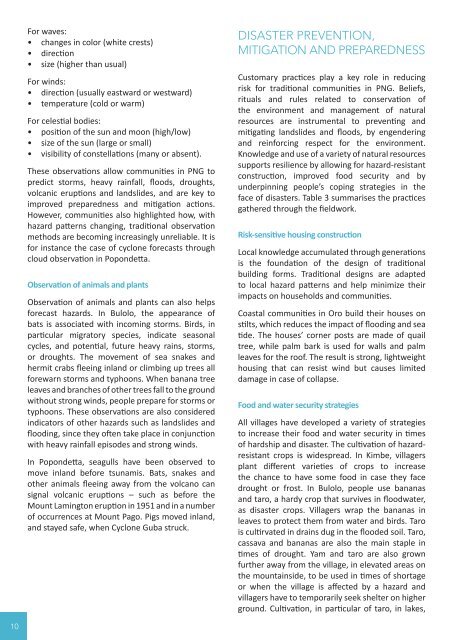INDIGENOUS KNOWLEDGE
PNG%20indigenous%20knowledge%20report%20print
PNG%20indigenous%20knowledge%20report%20print
Create successful ePaper yourself
Turn your PDF publications into a flip-book with our unique Google optimized e-Paper software.
For waves:<br />
• changes in color (white crests)<br />
• direction<br />
• size (higher than usual)<br />
For winds:<br />
• direction (usually eastward or westward)<br />
• temperature (cold or warm)<br />
For celestial bodies:<br />
• position of the sun and moon (high/low)<br />
• size of the sun (large or small)<br />
• visibility of constellations (many or absent).<br />
These observations allow communities in PNG to<br />
predict storms, heavy rainfall, floods, droughts,<br />
volcanic eruptions and landslides, and are key to<br />
improved preparedness and mitigation actions.<br />
However, communities also highlighted how, with<br />
hazard patterns changing, traditional observation<br />
methods are becoming increasingly unreliable. It is<br />
for instance the case of cyclone forecasts through<br />
cloud observation in Popondetta.<br />
Observation of animals and plants<br />
Observation of animals and plants can also helps<br />
forecast hazards. In Bulolo, the appearance of<br />
bats is associated with incoming storms. Birds, in<br />
particular migratory species, indicate seasonal<br />
cycles, and potential, future heavy rains, storms,<br />
or droughts. The movement of sea snakes and<br />
hermit crabs fleeing inland or climbing up trees all<br />
forewarn storms and typhoons. When banana tree<br />
leaves and branches of other trees fall to the ground<br />
without strong winds, people prepare for storms or<br />
typhoons. These observations are also considered<br />
indicators of other hazards such as landslides and<br />
flooding, since they often take place in conjunction<br />
with heavy rainfall episodes and strong winds.<br />
In Popondetta, seagulls have been observed to<br />
move inland before tsunamis. Bats, snakes and<br />
other animals fleeing away from the volcano can<br />
signal volcanic eruptions – such as before the<br />
Mount Lamington eruption in 1951 and in a number<br />
of occurrences at Mount Pago. Pigs moved inland,<br />
and stayed safe, when Cyclone Guba struck.<br />
DISASTER PREVENTION,<br />
MITIGATION AND PREPAREDNESS<br />
Customary practices play a key role in reducing<br />
risk for traditional communities in PNG. Beliefs,<br />
rituals and rules related to conservation of<br />
the environment and management of natural<br />
resources are instrumental to preventing and<br />
mitigating landslides and floods, by engendering<br />
and reinforcing respect for the environment.<br />
Knowledge and use of a variety of natural resources<br />
supports resilience by allowing for hazard-resistant<br />
construction, improved food security and by<br />
underpinning people’s coping strategies in the<br />
face of disasters. Table 3 summarises the practices<br />
gathered through the fieldwork.<br />
Risk-sensitive housing construction<br />
Local knowledge accumulated through generations<br />
is the foundation of the design of traditional<br />
building forms. Traditional designs are adapted<br />
to local hazard patterns and help minimize their<br />
impacts on households and communities.<br />
Coastal communities in Oro build their houses on<br />
stilts, which reduces the impact of flooding and sea<br />
tide. The houses’ corner posts are made of quail<br />
tree, while palm bark is used for walls and palm<br />
leaves for the roof. The result is strong, lightweight<br />
housing that can resist wind but causes limited<br />
damage in case of collapse.<br />
Food and water security strategies<br />
All villages have developed a variety of strategies<br />
to increase their food and water security in times<br />
of hardship and disaster. The cultivation of hazardresistant<br />
crops is widespread. In Kimbe, villagers<br />
plant different varieties of crops to increase<br />
the chance to have some food in case they face<br />
drought or frost. In Bulolo, people use bananas<br />
and taro, a hardy crop that survives in floodwater,<br />
as disaster crops. Villagers wrap the bananas in<br />
leaves to protect them from water and birds. Taro<br />
is cultirvated in drains dug in the flooded soil. Taro,<br />
cassava and bananas are also the main staple in<br />
times of drought. Yam and taro are also grown<br />
further away from the village, in elevated areas on<br />
the mountainside, to be used in times of shortage<br />
or when the village is affected by a hazard and<br />
villagers have to temporarily seek shelter on higher<br />
ground. Cultivation, in particular of taro, in lakes,<br />
10


